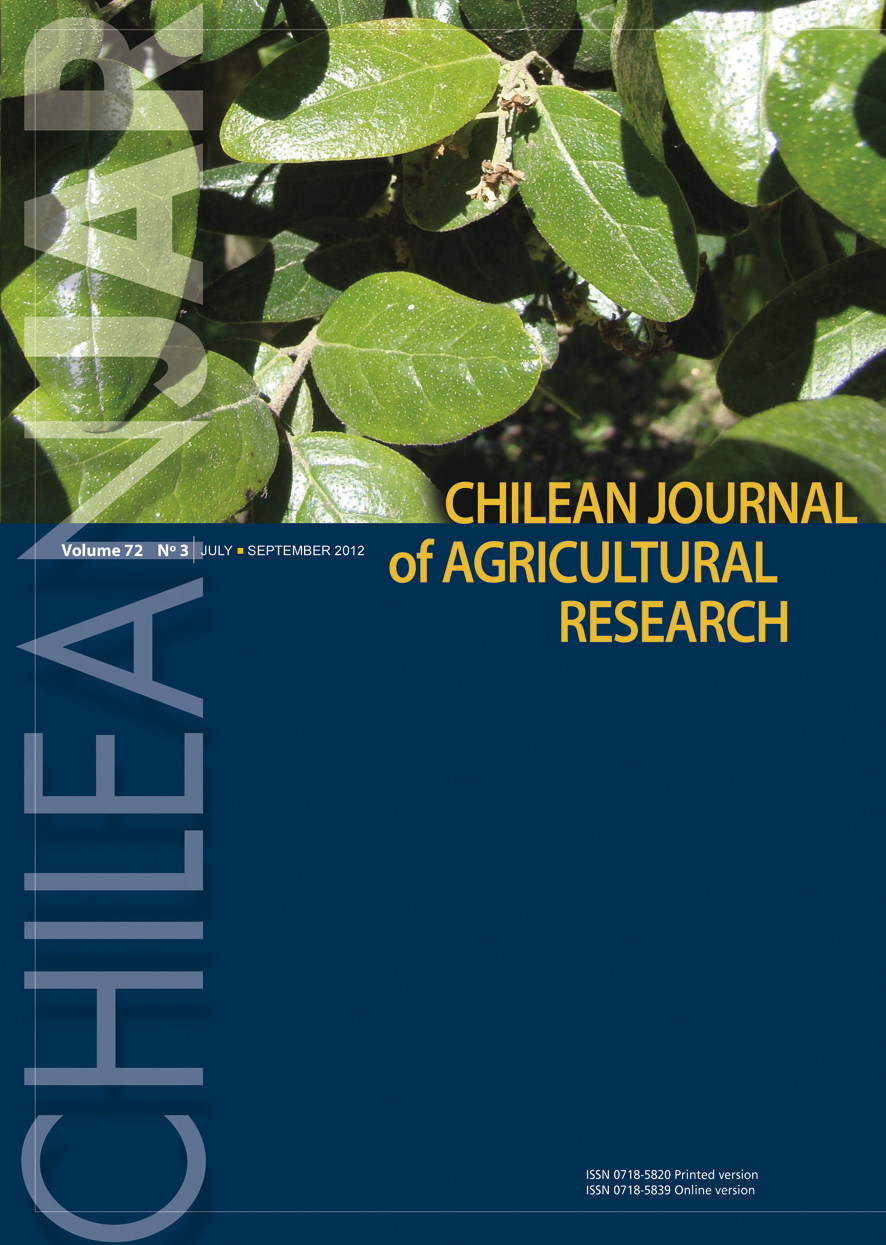
|
Chilean Journal of Agricultural Research
Instituto de Investigaciones Agropecuarias, INIA
ISSN: 0718-5820
EISSN: 0718-5820
Vol. 71, No. 2, 2011, pp. 283-292
|
 Bioline Code: cj11034
Bioline Code: cj11034
Full paper language: English
Document type: Research Article
Document available free of charge
|
|
|
Chilean Journal of Agricultural Research, Vol. 71, No. 2, 2011, pp. 283-292
| es |
Impacto del uso del suelo sobre las fracciones físicasde materia orgánica en tres Ferrasols de pendientesen México
Matus, Francisco; Hidalgo, Claudia; Monreal, Carlos; Estrada, Isabel; Fuentes, Mariela & Etchevers, Jorge
Resumen
Los efectos del cultivo de ladera (> 30% dependiente) sobre el C y N del suelo y su almacenamientodespués de la tala del bosque y sucesivo cultivo en nuevossitios de crecimiento del bosque no siempre induceuna pérdida de materia orgánica del suelo (SOM) enáreas subtropicales. En el presente estudio se evaluó la sensibilidad del cambio de la SOM del material que flota en agua (Fw), arena gruesa (> 250 µm), arena fina (50-250 µm), limo (2-50 µm) y arcilla (0-2 µm) por el impacto del cultivo en los Ferrasols mexicanos. Este estudio también determinó el grado de saturación relativo de C y N en laspartículas del tamaño de las arcillas y limo. Las fraccionesfísicas del suelo se obtuvieron con vibración ultrasónica yposterior sedimentación. El stock de materia orgánica enlos suelos cultivados varió desde 54 hasta 146 Mg C ha-1 ydesde 3,9 hasta 7,1 Mg N ha-1 y en suelos del bosque 46-94 Mg C ha-1 y 3,7-5,1 Mg N ha-1. La distribución relativa de C y N fue menor en la arena gruesa y mayor en la fracciónde limo; esta última siguió los cambios del C y N delsuelo. La arena gruesa fue la fracción más sensitiva queresponde a los efectos de la cultivación, lo que representaun reservorio de diagnóstico para evaluar los cambios de laSOM bajo cultivación. La mitad de las muestras de sueloestudiadas presentaron un bajo grado de saturación de C y N en las fracciones de limo y arcilla indicando que existe un potencial de estas fracciones para la acumulación de C y N, mientras que la otra mitad fueron muy por encima del límite de saturación.
Palabras-clave
N y C del suelo, tamaño de arenas, SOM saturación, dispersión ultrasónica
|
| |
| en |
Land use impacts on physical-based soil organic matter fractions on three hillside ferrasols in mexico
Matus, Francisco; Hidalgo, Claudia; Monreal, Carlos; Estrada, Isabel; Fuentes, Mariela & Etchevers, Jorge
Abstract
The effects of cultivation in hillside (> 30% slope) on soil C and N stocks after forest clearance and subsequent cultivation in new re-growth forest sites not always induce rapid soil organic matter (SOM) loss in subtropical areas. In the present study we evaluated the sensitivity to SOM changes of material floatable in water (Fw), coarse sand (> 250 µm), fine sand (50-250 µm), silt (2-50 µm) and clay (0-2 µm) fractions by the impact of cultivation of Mexican Ferrasols. This research also determined the relative degree of C and N saturation in the silt and clay size particles. The soil physical fractions were obtained after ultrasonic vibration and sedimentation. Soil organic matter stock (0-20 cm depth) in cultivated sites ranged from 54 to 146 Mg C ha-1 and from 3.9 to 7.1 Mg N ha-1 and in the forest soil 46-94 Mg C ha-1 and 3.7-5.1 Mg N ha-1. The relative distribution of C and N was lower in the coarse sand and highest in the silt fraction; the latter paralleled the changes of whole soil C and N. Coarse sand was the most sensitive fraction responding to cultivation, thus representing a diagnostic pool to assess the SOM shifts under cultivation. Half of our studied soil showed a low degree of C and N saturation in the silt and clay fraction indicating potential for accumulation of C and N, while the other half were well above the saturation limit.
Keywords
Soil C and N, sand-size, SOM saturation, Ultrasonic dispersion
|
| |
© Copyright 2010 Chilean Journal of Agricultural Research.
Alternative site location: http://www.inia.cl
|
|
